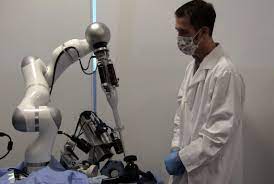Uses of computer in Computer-aided diagnosis (CAD)
Uses of computer in Computer-aided diagnosis (CAD)
Computer-aided
diagnosis (CAD) is a field of medicine that utilizes computer science to assist
healthcare professionals in the diagnosis of diseases and medical conditions.
There are several key uses of computer science in CAD, including:
1. Image
analysis: CAD systems use computer algorithms to analyze medical images, such
as X-rays, CT scans, and MRI images. These algorithms can detect abnormalities
or lesions that may not be visible to the human eye, which can improve the
accuracy of diagnoses.
2. Pattern
recognition: CAD systems use machine learning algorithms to recognize patterns
in medical images. These patterns can indicate the presence of a specific
disease or condition, which can help healthcare professionals make more
accurate diagnoses.
3. Decision
support: CAD systems can provide decision support to healthcare professionals
by analyzing medical images and providing information on the likelihood of a
specific diagnosis. This can help healthcare professionals make more informed
decisions and improve patient care.
4. Automated
detection: Computer-aided diagnosis systems use computer algorithms to
automatically detect abnormalities or lesions in medical images. This can
improve the efficiency and accuracy of diagnoses, as well as reduce the
workload of healthcare professionals.
5. Data
management: CAD systems can also be used to manage and organize large amounts
of patient data, including medical images, lab results, and patient history.
This can improve the efficiency of diagnoses and treatment planning.
6. Remote
diagnostics: CAD systems can be used to provide remote diagnostics, which
enables healthcare professionals to diagnose patients remotely. This is
particularly useful in rural or remote areas where access to healthcare is limited.
7. Radiotherapy
planning: CAD systems can be used to plan and simulate radiotherapy treatments,
which can help to improve the accuracy and effectiveness of the treatment.
8. Predictive
modeling: CAD systems can use predictive modeling techniques to predict the
likelihood of a patient developing a specific condition or disease. This can
help healthcare professionals to identify and treat patients at an early stage.
In
conclusion, computer-aided diagnosis (CAD) utilizes computer science to assist
healthcare professionals in the diagnosis of diseases and medical conditions.
CAD systems use computer algorithms to analyze medical images, recognize
patterns, provide decision support, automate detection, manage data, provide
remote diagnostics, plan radiotherapy and do predictive modeling which can
improve the accuracy and efficiency of diagnoses, as well as reduce the
workload of healthcare professionals.
.jpeg)
.jpeg)


That's great 😃
ReplyDelete